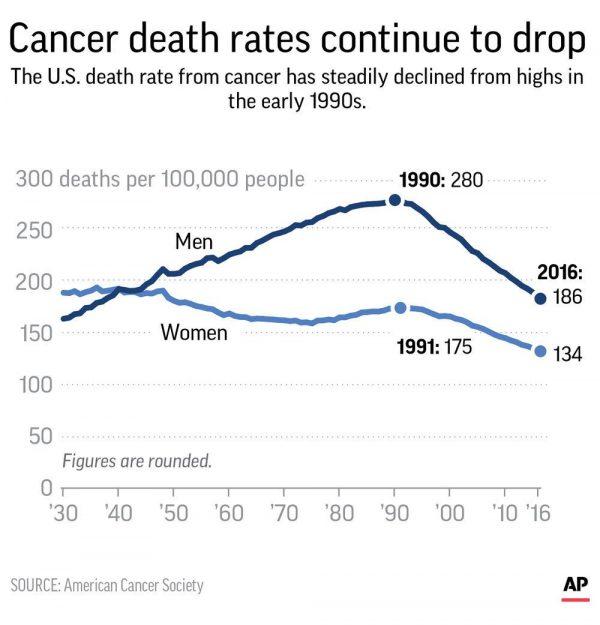NEW YORK—The U.S. cancer death rate has hit a milestone, falling for at least 25 years according to a new report.
Lower smoking rates are translating into fewer deaths. Advances in early detection and treatment are also having a positive impact, experts say.
However, obesity-related cancer deaths are rising and prostate cancer deaths are no longer dropping according to Rebecca Siegel, lead author of the American Cancer Society report published on Jan. 8.
Cancer also remains the nation’s number-two killer. The society predicts there will be more than 1.7 million new cancer cases, and more than 600,000 cancer deaths, across the United States this year.

Cancer Death Rates Drop
There’s been a lot of bad news recently regarding U.S. death rates. In 2017, fatalities from seven of the 10 leading causes of death increased according to the latest government data but cancer has been something of a bright spot.The nation’s cancer death rate increased until the early 1990s but has been dropping since, falling 27 percent between 1991 and 2016 according to the Cancer Society.
Mixed Results for Prostate Cancer Deaths
The report has produced some mixed news about prostate cancer, the second leading cause of cancer-related death in men.The prostate cancer death rate halved over two decades but experts wonder whether the trend changed after a 2011 decision from the U.S. Preventive Services Task Force to stop recommending routine testing of men using the PSA blood test. This decision was made due to concerns the test was leading to overdiagnosis and overtreatment.
Obesity Linked to Cancer
Of the most common types of cancer in the United States, all types with increasing death rates are linked to obesity, including cancer of the pancreas and uterus.Another type is liver cancer. Liver cancer deaths have increased since the 1970s and, initially, most of the increase was tied to hepatitis C infections spread among people who abuse drugs. However, obesity accounts for a third of liver cancer deaths and is a greater factor than hepatitis, Siegel said.
Racial Disparity in Cancer Deaths
There has been a decline in the historic racial gap in cancer death rates but an economic gap is growing—especially when it comes to deaths that could be prevented by early screening and treatment, better eating, and smoking less.In the early 1970s, colon cancer death rates in the poorest counties were 20 percent lower than those in affluent counties. Now they are 30 percent higher. Cervical cancer deaths are twice as high for women in poor counties now, compared with women in affluent counties. Lung and liver cancer death rates are 40 percent higher for men in poor counties.
Ohio State University’s Center for Cancer Health Equity deputy director Dr. Darrell Gray said the findings were “important but not surprising.”
“We’ve known for some time that race is a surrogate” for other factors, like poverty and difficulty getting to—or paying for—doctor’s appointments, he said.






Friends Read Free